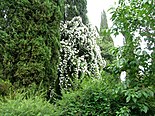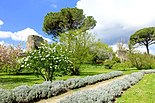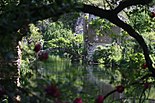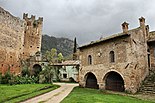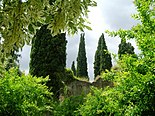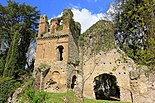Garden of Ninfa

The Garden of Ninfa is a garden in the territory of Cisterna di Latina, in the province of Latina, central Italy. The park has an area of 105 hectares (260 acres), and is an Italian natural monument.[1][2] The landscape garden within the park comprises 8 hectares (20 acres) and contains medieval ruins, several oaks, cypresses and poplars, grassy meadows, a wide range of exotic plants from various parts of the world, numerous watercourses and a large variety of rambling roses growing over the stone walls of the ruins. The site is run by the Italian foundation Fondazione Roffredo Caetani. It is open to the public at set times from April to November. Nearby towns include Norma and Sermoneta. Ninfa has been described as "the most romantic garden in the world".
History

The garden includes the ruins of the ancient settlement of Ninfa, whose name seems to derive from a classical era nymphaeum, a temple dedicated to nymphs, located on an island in the small lake; nymphs were believed to dwell in mountains and groves, by springs and rivers, and also in trees and in valleys and cool grottoes.[3] According to Charles Quest-Ritson's book Ninfa: The Most Romantic Garden in the World, the Gardens of Ninfa's first documented evidence is from Pliny the Younger, who described a temple on the premises dedicated to water nymphs.[4]
The village already existed in the Roman era as a small village in an agricultural area.

During the Middle Ages Ninfa had more than 150 houses, several churches, mills, bridges, two hospices, a castle and a town hall. The town was encircled by a defensive wall 1,400 metres (1,500 yd) in length with guard towers.[7]
The castle was built in the 12th century, located near the lake, outside the city walls. Santa Maria Maggiore was the town's primary church[8] and was most likely built from the 10th century and widened in the first half of the 12th century.
The Church of Saint John is dated around the 11th century and is now in ruins. The original structure most likely had a single nave with several lateral chapels and a semicircular apse, of which parts remain. Some traces of frescoes are still visible on the walls of the ruins.[6]

In the 16th century Ninfa was repopulated by its inhabitants, under the seigniory of the Caetani. Cardinal Nicolò III Caetani ordered the architect Francesco Perugino to build a garden in the area of Ninfa, but this garden fell into decay soon after the Cardinal's death in 1585. During the 17th century it was gradually deserted[8] due to the expansion of the surrounding marshes and the arrival of malaria.
By the 18th century the last mill was abandoned. In 1765 the town hall was transformed into a barn by Francesco,
Garden

The garden was created by
Quest-Ritson's description of the site:
The garden at Ninfa has a unique setting: the ruins of a medieval town near Rome. The site is one of sublime romantic beauty, where time seems to stand still. The garden has achieved cult status among the English and American gardening cognoscenti.
The garden has been called the world's most romantic garden,[7][13] also because of its location: it is "a romantic oasis of fertility in the midst of the heavily-industrialised Pontine Plain to the South East of Rome".[14]

The garden is crossed by numerous small springs as well as the river Ninfa, which flows south of the garden. Restoration of the garden involved importing plant species from all over the world.
The garden can be visited only with a guide, following a prescribed route.[17]
Fauna
Ninfa is located on a major flyway of birds migrating from Africa to Europe. The garden, the river and the lake house a rich variety of fauna, including the
Infrastructure
The garden is located 64km southeast of Rome. It may be reach by regional and Intercity trains from Roma Termini, calling at the station "Latina scalo". From there it is approximately 7km to the garden, which may be done by taxi in 10 minutes. Alternatively, the garden is connected to Rome by the S.S. 148 street.
Gallery
-
A white climbing rose
-
Medieval ruins
-
The river
-
Ruins
-
Garden of Ninfa ancient stone bridge
-
The ruins of the medieval village
-
The stream and meadows
-
Old arch from the Santa Maria Maggiore church
-
Cypresses
-
Tower of Santa Maria Maggiore
References
- World Wildlife Fund. Archived from the originalon 22 March 2014. Retrieved 30 March 2014.
- ^ Matheus, Michael (2023-01-23). "Ninfa: The Pompeii of the Middle Ages". Retrieved 2023-05-12.
- ^ Atsma, Aaron (2000–2011). "Nymphai". Theoi..com. Retrieved 30 March 2014.
- ^ Quest-Ritson 12-26.
- ^ "L'antica Città di Ninfa - Cisterna di Latina" (in Italian). Lazionascosco.it. Retrieved 30 March 2014.
- ^ a b "La storia di Ninfa nel medioevo" (in Italian). Retrieved 22 March 2010.
- ^ a b Randall, Frederika (16 June 2002). "Day Trip: A Secret Garden". The New York Times. p. 8. Retrieved 30 March 2014.
- ^ ISBN 978-1-86011-112-9
- ^ "Gardens of Ninfa". Italy Heaven. Retrieved 30 March 2014.
- ^ "Fondazione" (in Italian). Fondazione Roffredo Caetani. Retrieved 30 March 2014.
- ^ Quest-Ritson 61-78.
- ^ Quest-Ritson 36-48.
- ^ Quest-Ritson 10.
- ^ Walsh, Isobel (23 August 2006). "The Garden of Ninfa, Italy". Country Life. Retrieved 30 March 2014.
- ^ Gnoli 281–302.
- ^ "Giardini" (in Italian). Fondazione Roffredo Caetani. Archived from the original on 2 April 2010. Retrieved 30 March 2014.
- ^ Pasquali, Luca. "The Gardens of Ninfa". Life in Italy. Retrieved 30 March 2014.
- ^ a b "Oasi di Ninfa", Fondazione Roffredo Caetani, archived at the Wayback Machine, 26 May 2010 (in Italian)
Bibliography
- Gnoli, Fabiola (2010). Il ruolo di Ninfa nel paesaggio (in Italian).
- Quest-Ritson, Charles (2009). Ninfa: The Most Romantic Garden in the World. Frances Lincoln. ISBN 978-0711230477.
Further reading
- Luigi Fiorani. Ninfa, una città, un giardino. Rome: L'Erma di Bretschneider, 1990. ISBN 88-7062-710-1. (in Italian)
- Marella Caracciolo and Giuppi Pietromarchi. Il giardino di Ninfa, i fiori, le piante e i giardini. Turin: Allemandi, 2004. ISBN 88-422-0542-7. (in Italian)
- Pier Giacomo Sottoriva, Antonella Ponsillo, and Alessandra Vinciguerra. Il giardino di Ninfa - Mappa.
- Lucio Spiccia. Ninfa - Una storia millenaria. Latina: Littera Antiqua, 2004. (in Italian)
- Gretchen Kromer. Ninfa in Winter. San Francisco: Blurb, 2013. ISBN 0615875661.
- Michael Matheus (ed.) Ninfa. Percezioni nella scienza, letteratura e belle arti nel XIX e all’inizio del XX secolo. Regensburg, 2022, ISBN 978-3-7954-3740-4

